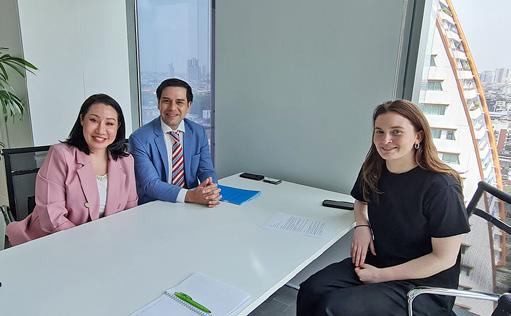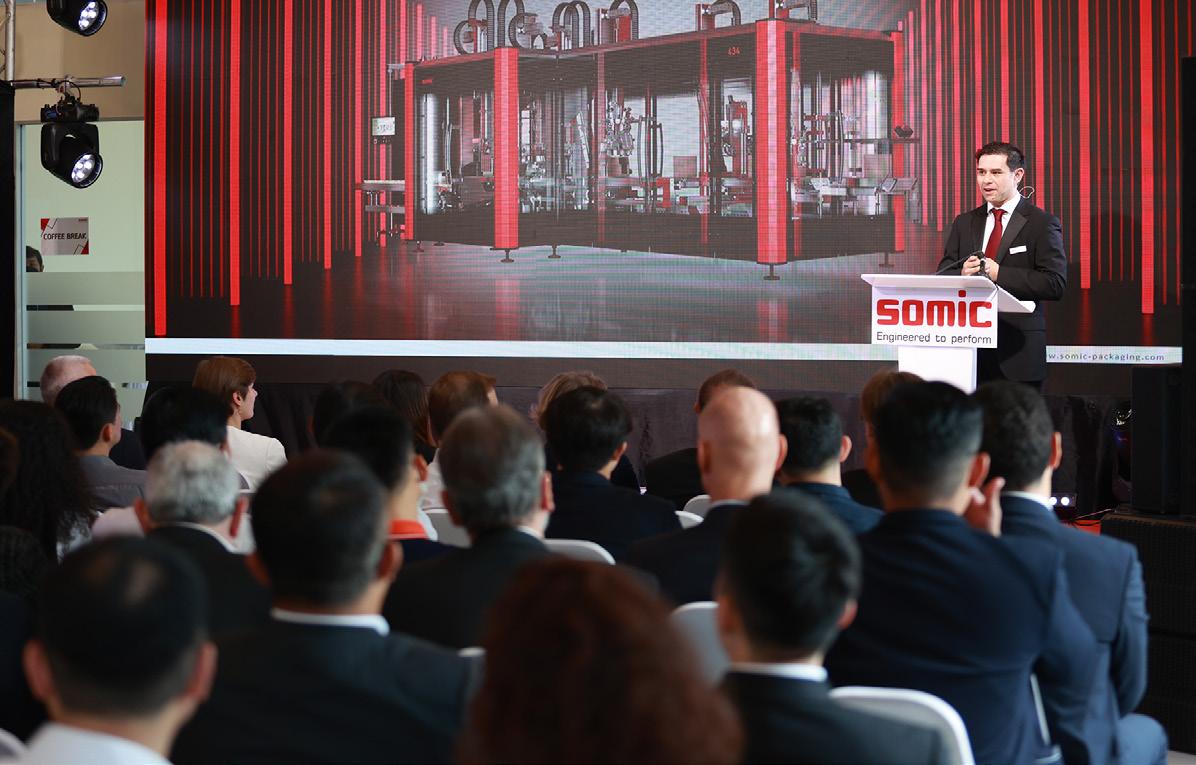
13 minute read
Unboxing the future of packaging with German solutions
Lukasz Myszkowski
Food packaging is an essential part of the food industry. It plays a crucial role in ensuring food quality and safety, facilitating distribution, acting as a barrier against external contaminants, and helping maintain freshness. It also extends the shelf life of food, reduces food waste, and supports the transport of food from production to consumption.
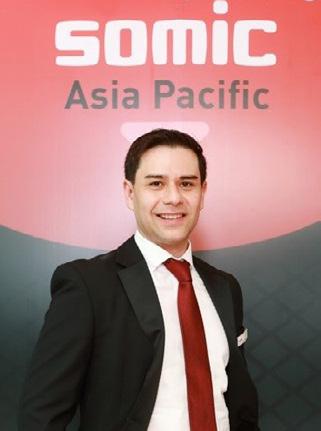
SOMIC is one of the leading global manufacturers of end-of-line (EOL) packaging machines, and is renowned for its highperformance, modular systems that meet the complex packaging needs of various industries – particularly the food and beverage sector. Having brought the German technology to Thailand, in 2023, SOMIC also plays a crucial role in enabling food manufacturers in the Asian Pacific region to meet rising consumer expectations for functional and sustainable packaging.
The GTCC recently interviewed Lukasz Myszkowski, Managing Director Sales at SOMIC Packing Asia-Pacific Co., Ltd., who offers some valuable insights into the current state and outlook of the Thai and Southeast Asian food markets, also discussing how his company is responding to the growing demand for sustainable solutions.
How would you describe the current situation regarding the food industry in Thailand and the broader Southeast Asian region? What are the key developments and outstanding trends?
Basically, I see two words: dynamic and abundant. Dynamic in the sense that it is ever evolving, as constantly influenced by global trends. It is also abundant, with the population in Asia being so large due to the calorific value of its staple food, rice. The fertility of its land also contributes to high yield farming. Therefore, it’s been an enabler for a growing population.
Regarding the current situation of the food industry, half of the major food producing countries are in Asia. From Southeast Asia there are three in the top ten – Thailand, Indonesia and Vietnam – while China is number one and India is number two. Thailand is now a net exporter, let's say for the last 20 years, in seafood, rice, and many others. Effectively, we have the reputation as the “kitchen of the world”. Cementing Thailand's reputation as a premium cuisine exporter.
Indonesia, home to 280 million people, focuses on processed foods, with a lot of food security investment for agricultural tech firms, etc. They are also positioning themselves as number one in halal foods. Having grown so much in the last decade, Indonesia has modernised and mechanised their agriculture, coffee and seafood production. Indonesia enjoys a similar situation to Thailand, with very fertile soils and strong agricultural practices. Malaysia, like Indonesia it positions itself with halal foods.
The Philippines is an anomaly because they are really the biggest food importer in Southeast Asia of food packaging, in terms of raw material. Thus, they have a very strong desire to grow towards feeding their own people from their own land. They used to have some cases when they were the top exporters, however, over the years they’ve dropped in the rankings, as other countries improved in agricultural technology. We do believe that they’ll improve significantly. currently Philippines’ GDP growth is about 8 per cent.
Regarding the trends of domestic consumption, people are shopping for convenience, healthier foods, and plant-based products, as well as transparency. The growing health-conscious younger generation, often turn over the product to check its nutritional value. Furthermore, in the ASEAN markets the actual portion size is critical, especially in the Philippines and Indonesia. Where daily spend is around $2 or less a day per family. For more mature markets like South Korea and Taiwan, spending is four or five times more per basket on average, where citizens visit stores around two to three times less. Thailand, meanwhile, more urbanized, follows a trend towards convenience and higher value.
Is the growth of Thailand’s food industry sustainable? What role does innovative packaging technology play in supporting the growth and sustainability of the food sector?
During the 1950s to 1970s, Thailand was predominantly an agrarian agricultural society, it suffered from low agricultural yields, low mechanisation, and poor irrigation systems. Food exports were much less than it is today. During King Rama IX's reign, his self-sufficient economic philosophy was a practical approach to sustainable agriculture whilst using limited resources effectively. The Royal Project Model has been very successful in introducing alternative crops in Northern Thailand, and by the 1980s Thailand transitioned to net food exporter, boosted by investments in irrigation, rural development, and agricultural R&D. Rice production surged as Thailand became the world’s top rice exporter for many years. This also spurred strong exports in seafood, sugar, cassava, poultry, and fruits.
Regarding innovative packaging technology for the growth and sustainability of the food sector, the core purpose of packaging is to protect the product. It is fundamental for decreasing spoilage and food wastage. Asia Pacific is a net contributor of innovation, and Asia globally leads in terms of R&D innovation. This has resulted in a wave of sustainability driven products.
The most stringent country when it comes to food packaging is Japan, both for the overall functionality and superiority of the packaging, which also has aesthetic appeal. According to the World Bank, China, Australia, Canada and – in fifth place – Thailand are the top five suppliers of food products to Japan. This underscores Thailand's reputation as a trusted food partner when it comes to food packaging innovation.
Which packaging technology innovations do you see as particularly influential for the future of the food industry?
The innovations I see as particularly important are those with the ability to improve shelf-life, to be cost effective, and to be easily recyclable or biodegradable without impacting the food chain with microplastics. I read in an article recently that the University of Tokyo just invented a new type of plastic that’s dissolvable, without leaving a trace of microplastics. This is groundbreaking. But the most important thing is marketability. If people don't buy it, it then unfortunately becomes a waste.
I see AI as the enabler to optimise functionality of production lines; collecting data and explaining to stakeholders how they can improve their business operation. AI also has high potential to replace jobs where automation has already started the process. In fact, we are experiencing what we call a disruptive 100-year cycle. It will create a mass disruption in how we operate things in the coming years. AI will probably be tuned by businesses towards productivity and profitability.
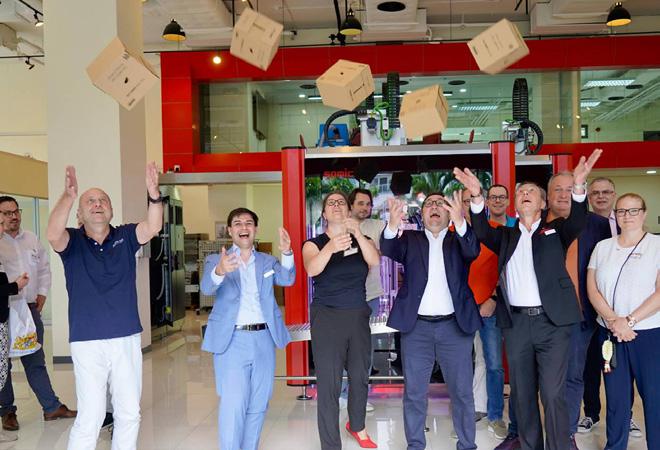
What are the main challenges currently facing the food packaging industry in Southeast Asia?
The main challenge is recycling and sustainability due to cost. Flexible plastics are cheap to produce but are costly to collect and recycle. The cost to build, install, and commission a recycling plant for advanced recycling of plastics is prohibitive, with a long lead time, which is why steps were taken to go to mono-material plastics to reduce the burden of costly advanced recycling facilities.
The private sector has documented life cycle analysis of plastics, and the value add from recycling is generally less than virgin material. However, post consumer recycling (PCR) is creating feedstock that today is in high demand because of the sustainability pledges of 2025, 2030, and beyond, which are binding. This doesn’t stop the problem at the root cause but is simply a steppingstone towards the inevitable phase out of certain applications of plastics. The European Commission, during the Covid-19 pandemic, took active steps, taxing products that have a negative impact on their recycling infrastructure.
The opportunity is for governments globally to realise the cost of landfills, and the negative impact on health, and study the life cycle analysis of all packaged goods. If they choose to invest heavily in this area, then I see an opportunity for the implementation of more government and privately led sustainability initiatives.
How is SOMIC responding to the growing global demand for sustainable and environmentally friendly packaging solutions?
Over the past five decades, SOMIC has built its reputation as a leader in secondary packaging. Our business thrives because we follow three pillars of sustainability. The first one is ecological sustainability. We design the machines with the environment in mind. Our machines are compact, modular, and built to last whilst maintaining the precision and handling quality – something we’re known for –which enables a minimum carbon footprint. Manufacturing powered by renewable energy ensures a cleaner future and supports our sustainability goals.
The second pillar is economic sustainability. For businesses to adopt sustainable practices, those practices must also make economic sense. We see carton-based secondary packaging as one of the strongest business cases. It's the most widely recycled type of secondary packaging in the world, and even when it isn't recycled, it naturally biodegrades. We offer smart, compact packaging solutions that reduce material waste and save companies money through optimised design. When combined with compact design, efficient operations and cost-effectiveness customers can expect a strong return on investment, proving sustainable practices can align with, and even enhance, business performance.
The final pillar is social sustainability. As a family-founded business, we have strong values that drive our success, and we invest in our people. It’s important for us to support local communities by creating highly skilled jobs and fostering equal growth opportunities in the company, regardless of the person’s background.
What is your vision for SOMIC in Thailand and Southeast Asia over the next five years? What unique aspects of the region must be considered?
My vision is the shared vision of the group; to be preferred supplier of shelf-ready packaging machinery for the food industry. Our value proposition is based on five core principles. Number one is quality – made in Germany and, more importantly, made by SOMIC. Our supply chain is strengthened through a high percentage of vertical integration, and thismeans 70 to 80 per cent of the machines are made by us. Therefore, we can provide in-house quality.
The second is precision. We treat each of our customers’ products with utmost care when they enter our machine domain. We make sure to handle all products sensitively and consistently with optimised design. We want to show our clients that we really care about their product, and that its presentation matters to us.
Third is efficiency, and by that we mean material savings, line efficiency and fast changeovers, and a compact footprint with POS marketability. This enables us to compound the returns not only on our machine but benefiting the whole value chain.
Our next core value is sustainability. We advocate for circularity. Instead of just talking about “carbon neutrality” or “zero waste”, we want to push this to a new level and remove harmful plastics from circulation. We do this by using cartons as our fundamental choice packaging material.
The final core principle is service, which is our most important value. SOMIC strives to be the experts in EOL, consulting locally, in your language – and giving clients a true customercentric experience.
When it comes to regional aspects, we want to bring quintessential bespoke German engineering experience to meet the stringent local market requirements. In Asia-Pacific (APAC), service is the top priority. Therefore, our teams have been handpicked with a customer leading mentality in mind. The APAC region is also the most competitive in the world, but in the FMCG industry true value is realised when Asian brands can successfully export their product outside of Asia to Europe and North America. A great example is the Korean food industry, partnering with K Pop culture in music and movies, where food is stealthily marketed to consumers. They want to immerse themselves in the culture, and food is a great start.
SOMIC is catering to those customers who want to break into international markets, who want to bring their excellence in local flavours to the world. As such, the insight that we have, leading in those markets, provides immense value for brands in the APAC market.
How is SOMIC strategically positioning itself in the Southeast Asian market? What’s the competitive advantage of SOMIC over competitors?
We have taken the initiative to invest in engineering, R&D, service, sales, and even our own Demo Centre so that our customers can walk into our offices to have a customised experience right at their doorstep. We’ve learned in the past that a simple one-man show is not the right approach, and we wanted to create a slice of Amerang, Bavaria, in Bangkok.
Now the market is well established – a red ocean of credible suppliers who can do the job. But the difference is the marketability potential that one machine can create, and the value chain benefits investing in a SOMIC fundamentally brings.
What are your key collaborations with local partners in the food industry?
SOMIC collaborates with its various companies through the value chain, from converters producing corrugated board and OEM suppliers that provide equipment required to be integrated in the line, to service partners, supply chain partners, our customers, and retailers. The key collaboration is a partner who buys into the same philosophy as we have and provides their expertise to the best of their capability.
We fundamentally would like to be known for doing one thing right, and that is making the best case-packers for the food industry and to be number 1 supplier of Shelf-Ready Packaging solutions. We believe that our key collaborators truly have a core business focus, even if they have offshoot business units. As the famous saying goes, “A jack of all trades is a master of none, but oftentimes better than a master of one.” Therefore, collaboration is essential.
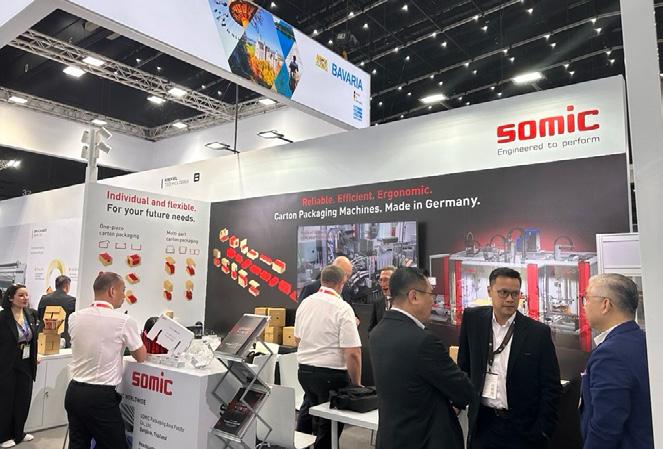
Has SOMIC received the promotions from Thailand’s Board of Investment? If so, for how long and in what category?
Yes, SOMIC has been granted an investment promotion, in the Business of Trade and Investment Support Office, under category 7.7: Trade and investment office: TISO. Our company has been registered since December 2022 and has been officially approved by the BOI since February 2023.
Overall, we have been operating under the BOI for just under 2.5 years, and this has made business operations smoother. It allows us to hire expatriates, provided they contribute to knowledge transfer, which is a key focus. The BOI also offers various options for setting up offices or manufacturing facilities, depending on business needs. We began with a basic structure to establish our presence, but may apply for a different BOI category in the future if we move into manufacturing.
Interviewed by Chadaphan Maliphan and Philippine Fromholzer, GTCC Team
Contact details:
Lukasz Myszkowski
Managing Director Sales APAC
SOMIC Packaging Asia Pacific CO., Ltd.
